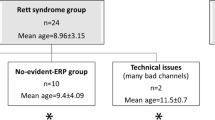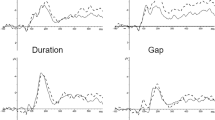Abstract
Many neuropsychological disorders, especially attentional abnormality, are present in patients with myotonic dystrophy type 1 (DM1), but the underlying mechanisms remain unclear. This study aimed to evaluate attention function by auditory event-related potential (ERP) P3a (novelty paradigm) in DM1 patients. A total of 10 young DM1 patients (mean age 30.4 years) and 14 age-matched normal controls participated in this study. ERPs were recorded using an auditory novel paradigm, consisting of three types of stimuli, i.e., standard sound (70%), target sound (20%), and various novel sounds (10%), and participants pressed buttons to the target sounds. ERP components P3b after the target stimuli and P3a following the novel stimuli were analyzed. Correlations of neuropsychological evaluations with the amplitudes and latencies of P3b and P3a were analyzed in DM1 patients. We found that P3a latency was significantly delayed in patients with DM1 compared with normal controls, although the latency and amplitude of P3b in DM1 patients were comparable with those in normal controls. The achievement rates of both the Symbol Digit Modality Test and the Paced Auditory Serial Addition Test were significantly correlated with P3a amplitude, as well as P3b amplitude. These results suggest that ERPs, including P3a and P3b, provide important insights into the physiological basis of neuropsychological abnormalities in patients with DM1, especially from the viewpoint of the frontal lobe and attention function.


Similar content being viewed by others
Availability of data and material
Anonymized data published within this article will be made available by request from any qualified investigator.
References
Brook JD, McCurrach ME, Harley HG et al (1992) Molecular basis of myotonic dystrophy: expansion of a trinucleotide (CTG) repeat at the 3′ end of a transcript encoding a protein kinase family member. Cell 68:799–808 (PMID: 1310900)
Lin X, Miller JW, Mankodi A et al (2006) Failure of MBNL1-dependent post-natal splicing transitions in myotonic dystrophy. Hum Mol Genet 15:2087–2097
Caillet-Boudin ML, Fernandez-Gomez FJ, Tran H et al (2014) Brain pathology in myotonic dystrophy: when tauopathy meets spliceopathy and RNAopathy. Front Mol Neurosci. 6:57. https://doi.org/10.3389/fnmol.2013.00057 (PMID: 24409116)
Vermersch P, Sergeant N, Ruchoux MM et al (1996) Specific tau variants in the brains of patients with myotonic dystrophy. Neurology 47(3):711–717
Minnerop M, Gliem C, Kornblum C (2018) Current progress in cns imaging of myotonic dystrophy. Front Neurol. 9:646. https://doi.org/10.3389/fneur.2018.00646 (eCollection 2018, PMID:30186217)
Okkersen K, Monckton DG, Le N et al (2017) Brain imaging in myotonic dystrophy type 1: a systematic review. Neurology 89(9):960–969. https://doi.org/10.1212/WNL.0000000000004300 (PMID:28768849)
Bajrami A, Azman F, Yayla V et al (2017) MRI findings and cognitive functions in a small cohort of myotonic dystrophy type 1: retrospective analyses. Neuroradiol J 30(1):23–27
Glantz RH, Wright RB, Huckman MS, Garron DC, Siegel IM (1988) Central nervous system magnetic resonance imaging findings in myotonic dystrophy. Arch Neurol 45(1):36–37 (PMID:3337674)
Huber SJ, Kissel JT, Shuttleworth EC, Chakeres DW, Clapp LE, Brogan MA (1989) Magnetic resonance imaging and clinical correlates of intellectual impairment in myotonic dystrophy. Arch Neurol 46(5):536–540 (PMID:2636847)
Ota M, Sato N, Ohya Y et al (2006) Relationship between diffusion tensor imaging and brain morphology in patients with myotonic dystrophy. Neurosci Lett 407(3):234–239 (PMID:16978781)
Romeo V, Pegoraro E, Ferrati C et al (2010) Brain involvement in myotonic dystrophies: neuroimaging and neuropsychological comparative study in DM1 and DM2. J Neurol 257(8):1246–1255
Takado Y, Terajima K, Ohkubo M et al (2015) Diffuse brain abnormalities in myotonic dystrophy type 1 detected by 3.0 t proton magnetic resonance spectroscopy. Eur Neurol 73(3–4):247–256
Okkersen K, Buskes M, Groenewoud J et al (2017) The cognitive profile of myotonic dystrophy type 1: a systematic review and meta-analysis. Cortex 95:143–155 (PMID:28892766)
Fujino H, Shingaki H, Suwazono S et al (2018) Cognitive impairment and quality of life in patients with myotonic dystrophy type 1. Muscle Nerve 57(5):742–748 (PMID:29193182)
Sutton S, Braren M, Zubin J, John ER (1965) Evoked-potential correlates of stimulus uncertainty. Science 150(3700):1187–1188 (PMID:5852977)
Soltani M, Knight RT (2000) Neural origins of the P300. Crit Rev Neurobiol 14(3–4):199–224 (PMID:12645958)
Herrmann CS, Knight RT (2001) Mechanisms of human attention: event-related potentials and oscillations. Neurosci Biobehav Rev 25(6):465–476 (PMID:11595268)
Helfrich RF, Knight RT (2019) Cognitive neurophysiology: event-related potentials. Handb Clin Neurol 160:543–558 (PMID:31277875)
Polich J, Herbst KL (2000) P300 as a clinical assay: rationale, evaluation, and findings. Int J Psychophysiol 38(1):3–19 (PMID:11027791)
Hedges D, Janis R, Mickelson S, Keith C, Bennett D, Brown BL (2016) P300 amplitude in Alzheimer’s disease: a meta-analysis and meta-regression. Clin EEG Neurosci 47(1):48–55. https://doi.org/10.1177/1550059414550567 (PMID: 25253434)
Jiang S, Qu C, Wang F et al (2015) Using event-related potential P300 as an electrophysiological marker for differential diagnosis and to predict the progression of mild cognitive impairment: a meta-analysis. Neurol Sci 36(7):1105–1112
Goodin DS, Squires KC, Henderson BH, Starr A (1978) Age-related variations in evoked potentials to auditory stimuli in normal human subjects. Electroencephalogr Clin Neurophysiol 44(4):447–458 (PMID: 76553)
van Dinteren R, Arns M, Jongsma ML, Kessels RP (2014) P300 development across the lifespan: a systematic review and meta-analysis. PLoS ONE 9(2):e87347 (PMID: 24551055)
Barceló F, Suwazono S, Knight RT (2000) Prefrontal modulation of visual processing in humans. Nat Neurosci 3(4):399–403 (PMID:10725931)
Suwazono S, Machado L, Knight RT (2000) Predictive value of novel stimuli modifies visual event-related potentials and behavior. Clin Neurophysiol 111(1):29–39 (PMID:10656508)
Hanafusa H, Motomura N, Asaba H, Sakai T, Kawamura H (1989) Event-related potentials (P300) in myotonic dystrophy. Acta Neurol Scand 80(2):111–113 (PMID: 2816271)
Perini GI, Colombo G, Armani M et al (1989) Intellectual impairment and cognitive evoked potentials in myotonic dystrophy. J Nerv Ment Dis 177(12):750–754 (PMID: 2592965)
Ragazzoni A, Pinto F, Taiuti R, Silveri MC (1991) Myotonic dystrophy: an electrophysiological study of cognitive deficits. Can J Neurol Sci 18(3):300–306 (PMID: 1913364)
Kazis A, Kimiskidis V, Georgiadis G, Kapinas G (1996) Cognitive event-related potentials and magnetic resonance imaging in myotonic dystrophy. Neurophysiol Clin 26(2):75–84 (PMID: 8767321)
Oliveri M, Fierro B, Lo Presti R et al (1999) P300 and respiratory findings in myotonic muscular dystrophy. Funct Neurol 14(3):149–154 (PMID: 10568215)
Tanaka H, Arai M, Harada M, Hozumi A, Hirata K (2012) Cognition and event-related potentials in adult-onset non-demented myotonic dystrophy type 1. Clin Neurophysiol 123(2):261–269. https://doi.org/10.1016/j.clinph.2011.06.012 (PMID:21741303)
Squires NK, Squires KC, Hillyard SA (1975) Two varieties of long-latency positive waves evoked by unpredictable auditory stimuli in man. Electroencephalogr Clin Neurophysiol 38(4):387–401 (PMID:46819)
Courchesne E, Hillyard SA, Galambos R (1975) Stimulus novelty, task relevance and the visual evoked potential in man. Electroencephalogr Clin Neurophysiol 39(2):131–143 (PMID:50210)
Friedman D, Cycowicz YM, Gaeta H (2001) The novelty P3: an event-related brain potential (ERP) sign of the brain’s evaluation of novelty. Neurosci Biobehav Rev 25(4):355–373 (PMID: 11445140)
Knight RT, Scabini D, Woods DL, Clayworth CC (1989) Contributions of temporal-parietal junction to the human auditory P3. Brain Res 502(1):109–116. https://doi.org/10.1016/0006-8993(89)90466-6 (PMID: 2819449)
Jasper HH (1958) The ten-twenty electrode system of the international federation. Electroencephalogr Clin Neurophysiol 10:371–375
Stephenson WA, Gibbs FA (1951) A balanced non-cephalic reference electrode. Electroencephalogr Clin Neurophysiol 3(2):237–240 (PMID:14840404)
Suwazono S, Arao H (2020) A newly developed free software tool set for averaging electroencephalogram implemented in the perl programming language. Heliyon 6(11):e05580 (PMID: 33319641)
Bertram M, Warren CV, Lange F et al (2020) Dopaminergic modulation of novelty repetition in Parkinson’s disease: a study of P3 event-related brain potentials. Clin Neurophysiol. 131(12):2841–2850 (PMID: 33137574)
Pedroso RV, Fraga FJ, Corazza DI, Andreatto CA, Coelho FG, Costa JL, Santos-Galduróz RF (2012) P300 latency and amplitude in Alzheimer’s disease: a systematic review. Braz J Otorhinolaryngol 78(4):126–132 (PMID: 22936149)
Drago V, Babiloni C, Bartrés-Faz D et al (2011) Disease tracking markers for Alzheimer’s disease at the prodromal (MCI) stage. J Alzheimers Dis 26(Suppl 3):159–199 (PMID: 21971460)
Dauwels J, Vialatte F, Cichocki A (2010) Diagnosis of Alzheimer’s disease from EEG signals: where are we standing? Curr Alzheimer Res 7(6):487–505 (PMID: 20455865)
Justen C, Herbert C (2018) The spatio-temporal dynamics of deviance and target detection in the passive and active auditory oddball paradigm: a sLORETA study. BMC Neurosci 19(1):25 (PMID:29673322)
Park JS, Seo J, Cha H et al (2018) Altered power spectral density in the resting-state sensorimotor network in patients with myotonic dystrophy type 1. Sci Rep 8(1):987 (PMID:29343751)
Delplanque S, Silvert L, Hot P, Rigoulot S, Sequeira H (2006) Arousal and valence effects on event-related P3a and P3b during emotional categorization. Int J Psychophysiol 60(3):315–322 (PMID:16226819)
Justo-Guillén E, Ricardo-Garcell J, Rodríguez-Camacho M, Rodríguez-Agudelo Y, Lelo de Larrea-Mancera ES, Solís-Vivanco R (2019) Auditory mismatch detection, distraction, and attentional reorientation (MMN-P3a-RON) in neurological and psychiatric disorders: a review. Int J Psychophysiol. 146:85–100 (PMID: 31654696)
Correa-Jaraba KS, Lindín M, Díaz F (2018) Increased amplitude of the p3a erp component as a neurocognitive marker for differentiating amnestic subtypes of mild cognitive impairment. Front Aging Neurosci 10:19 (PMID: 29483869)
Kaur M, Lagopoulos J, Ward PB, Watson TL, Naismith SL, Hickie IB, Hermens DF (2012) Mismatch negativity/P3a complex in young people with psychiatric disorders: a cluster analysis. PLoS ONE 7(12):e51871 (PMID:23251645)
Gourdon G, Meola G (2017) Myotonic dystrophies: state of the art of new therapeutic developments for the CNS. Front Cell Neurosci 11:101 (eCollection 2017, PMID:28473756)
Nakamori M, Panigrahi GB, Lanni S et al (2020) A slipped-CAG DNA-binding small molecule induces trinucleotide-repeat contractions in vivo. Nat Genet 52(2):146–159 (PMID:32060489)
Acknowledgements
We appreciate the technical support by Ms. Megumi Okuma and Mr. Naoki Yoshimura. We thank Editage (http://www.editage.com) for English language editing.
Funding
This study was supported by Grant-in-Aid for the Japan Agency for Medical Research and Development (JP19ek0109259 and JP20ek0109474) and Grant-in-Aid for Scientific Research KAKENHI (C) (18K11406 and 20K00539).
Author information
Authors and Affiliations
Contributions
SS, MD, PhD: study concept, design, and ERP data collection and analysis, and writing the first draft; HA, PhD: study design, data interpretation, and manuscript editing; YU, PhD: data interpretation and manuscript editing; SM, MPs: data interpretation and manuscript editing.
Corresponding author
Ethics declarations
Conflicts of interest
The authors have no conflicts of interest to declare.
Ethics approval
The present study was approved by the institutional review board of the National Hospital Organization Okinawa National Hospital (#25-03, #26-23). The procedures used in this study adhered to the tenets of the Declaration of Helsinki. All the participants signed informed consent before attending the recording of ERPs.
Consent to participate
Informed consent was obtained from all individual participants included in the study.
Rights and permissions
About this article
Cite this article
Suwazono, S., Arao, H., Ueda, Y. et al. Event-related potentials using the auditory novel paradigm in patients with myotonic dystrophy. J Neurol 268, 2900–2907 (2021). https://doi.org/10.1007/s00415-021-10465-1
Received:
Accepted:
Published:
Issue Date:
DOI: https://doi.org/10.1007/s00415-021-10465-1




